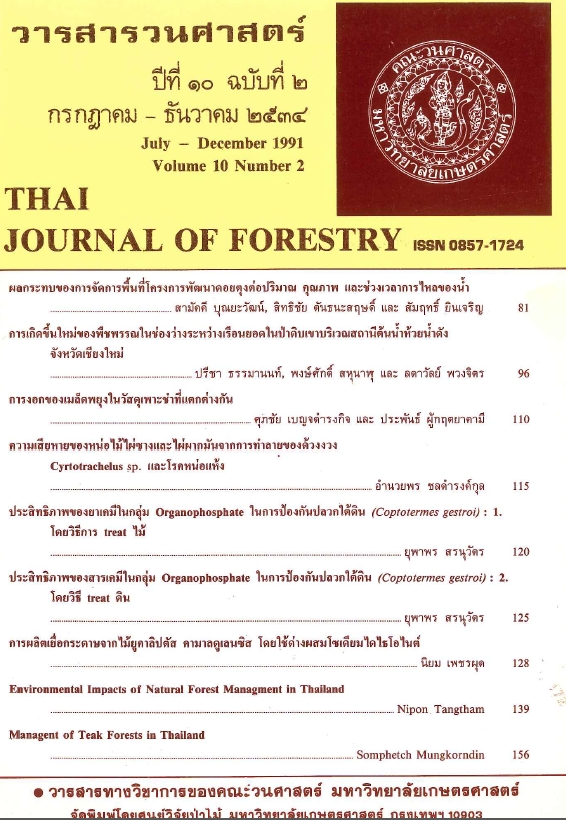MANAGEMENT OF TEAK FORESTS IN THAILAND
Main Article Content
บทคัดย่อ
Natural occurrence of teak is found in India, Myanmar, Thailand, Lao and Indonesia. In the olden days, teak forests of Thailand covered 170,000 km,2 but in 1984, shrunk to about 25,000 km.2 Before Royal Forest Department was established, teak forest belonged to the princes of the North. Teak leases were granted to individuals, private and European companies. Grantees paid only bidding fees and stump fees. In 1896, Royal Forest Department was established; the teak forests were revoked as public domain. Teak forests were leased with more proper rules and regulations, employing Brandis yield regulation method. Cutting cycle was 30 years, minimum girth limit was prescribed and Modified Selection Silvicultural System was used. In 1967, teak forest management plans were revised and updated. Eighteen forest management units in the North, responsible for management works, were practicing Selection cum Improvement Felling. This study includes the principles of Brandis method. Later, Royal Forest Department experimented with clear cutting system with artificial regeneration (reforestation) in some places. Some neighboring countries report application of Uniform System, but there is no evident conclusion. Because teak forests are deteriorated gradually, coupled with no more reliance on imports, it is urgent to manage the teak forests by choosing among three levels of objectives, viz., status quo management, use Selection cum Improvement Felling, low yield; convert some areas in plantation, use of shelterwood system, the rest in selection system, medium yield; and intensive management, deliberate plantations plus intensive silvicultural practices such as group selection, shelterwood system, or area- volume allotment, high cost but high yield
Downloads
Article Details

อนุญาตภายใต้เงื่อนไข Creative Commons Attribution-NonCommercial-NoDerivatives 4.0 International License.
ข้าพเจ้าและผู้เขียนร่วม (ถ้ามี) ขอรับรองว่า ต้นฉบับที่เสนอมานี้ยังไม่เคยได้รับการตีพิมพ์และไม่ได้อยู่ในระหว่างกระบวนการพิจารณาตีพิมพ์ลงในวารสารหรือสิ่งตีพิมพ์อื่นใด ข้าพเจ้าและผู้เขียนร่วม (ถ้ามี) ยอมรับหลักเกณฑ์และเงื่อนไขการพิจารณาต้นฉบับ ทั้งยินยอมให้กองบรรณาธิการมีสิทธิ์พิจารณาและตรวจแก้ต้นฉบับได้ตามที่เห็นสมควร พร้อมนี้ขอมอบลิขสิทธิ์ผลงานที่ได้รับการตีพิมพ์ให้แก่วารสารวนศาสตร์ คณะวนศาสตร์ มหาวิทยาลัยเกษตรศาสตร์ กรณีมีการฟ้องร้องเรื่องการละเมิดลิขสิทธิ์เกี่ยวกับภาพ กราฟ ข้อความส่วนใดส่วนหนึ่ง หรือ ข้อคิดเห็นที่ปรากฏในผลงาน ให้เป็นความรับผิดชอบของข้าพเจ้าและผู้เขียนร่วม (ถ้ามี) แต่เพียงฝ่ายเดียว และหากข้าพเจ้าและผู้เขียนร่วม (ถ้ามี) ประสงค์ถอนบทความในระหว่างกระบวนการพิจารณาของทางวารสาร ข้าพเจ้าและผู้เขียนร่วม (ถ้ามี) ยินดีรับผิดชอบค่าใช้จ่ายทั้งหมดที่เกิดขึ้นในกระบวนการพิจารณาบทความนั้น”


